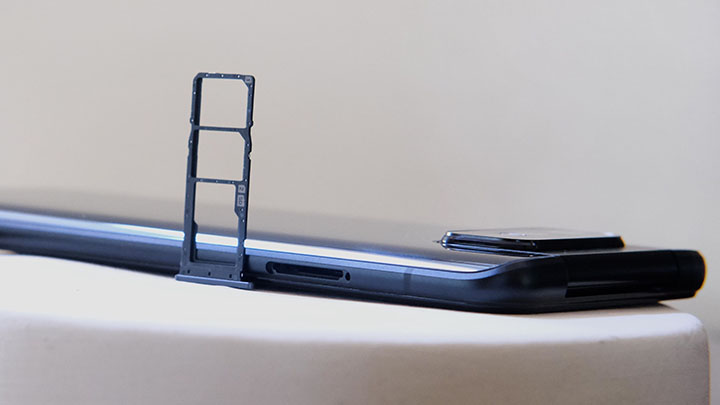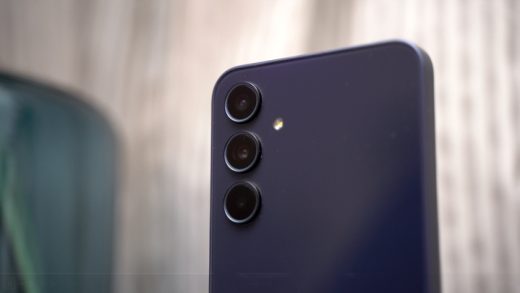ASUS recently launched the Zenfone 8, which took a different direction from its predecessor, by walking back on some of its features and reserving it for the new Zenfone 8 Flip, which we have in our hands to test out. The Zenfone 8 Flip stands out with its triple rotating camera to perform the rear and front camera functions in a similar way to what we saw in the Zenfone 6 Flip and Zenfone 7 Pro. However, aside from being cool, is it worth it? Let’s find out.

Table of Contents
Design and Construction
The ZenFone 8 Flip isn’t a small or compact phone by any means; we get a display size at 6.67-inch with slim bezels all around and quite a thicker chin. At 230g, the Zenfone 8 Flip feels hefty but robust, and once you hold the phone, you can immediately tell that it’s a premium device, thanks to its aluminum frame, Gorilla Glass 6 on the front, and 3D Curved Corning Gorilla Glass 3 at the back.

Our unit has the Galactic Black colorway, but it is also available in Glacier Silver. The back shines depending on the angle of the lighting and looks like brushed aluminum. Also, at the back, we’ll find the ASUS Zenfone Branding and the cameras, which is the reason why this device is called the “Flip.” It’s also worth knowing that this device is slippery to hold, so better use the free hard case that’s included in the box for safety use.

For buttons and ports, on the left, we’ll find the dual-SIM tray with a dedicated microSD card slot.

On the right are the volume and a blue-colored power button.

Below we have the LED indicator, USB Type-C port, main microphone, and loudspeaker. Meanwhile, up top is a noise-canceling microphone.
Display and Multimedia
Taking a closer look at the display, one of the key benefits of having a flip camera is that the screen won’t be interrupted by any selfie camera. Not much has changed in terms of design since the last generation of Zenfones. The Zenfone 8 Flip sports a 6.67-inch Super AMOLED panel with 2400 x 1080 resolution or equal to 395ppi, support for HDR10+, 200Hz touch sampling rate, and a 90Hz refresh rate, making everything smoother.

Quality is good as it is bright and produces punchy colors with enough detail. And because of the camera design, there’s no notch or hole punch for a more immersive viewing experience. You get the ability to customize the display via the Splendid options in the Display menu.

The large size and its ROG expertise also make the speakers in this device perform well, filling the room with sound and with the most bass you can get out of smartphone speakers. The sound profile emphasizes vocal frequencies, but you get to adjust the sound profile to your liking through the AudioWizard app in the settings, with its scenario-based enhancement, Graphic EQ, and Bass and Treble level control.
Camera

We did have some fun with its flipping camera, which ASUS claims to withstand 300,000 flips – or over 150 flips per day for five years. The hinge mechanism, which ASUS calls “liquid metal,” is also equipped with sensors to detect if the device is falling off and retract the camera to a safe position relatively quickly. While this provides some form of comfort, considering that the hinge is a moving part, we recommend against trying it out yourself to save your sanity. As for the urge to flip the camera again and again, better get a fidget spinner instead.

The Zenfone 8 Flip packs a triple camera setup in a flipping module. It houses the 64MP Sony’s IMX686 F1.8 main camera and a 12MP Sony IMX363 F2.2 ultra-wide, 8MP OmniVision F2.4 telephoto. It gets up to 3x optical zoom, has autofocus, but no OIS here.
It’s got Slo-Mo, Time-lapse, Portrait, Panorama, Document, Motion tracking, Pro, Pro Video, and Night mode. Also, one thing we enjoyed using the Flip camera is there are also special shooting modes, like object tracking that’ll move the module to keep the subject in the shot and an automatic panorama mode that uses the module to take a panoramic shot free of stitching issues, made possible by the adjustable camera system.
When it comes to quality, the ZenFone 8 Flip produces great results in a variety of shooting conditions, especially for selfies. It produces appealing colors without going into excessive saturation, and there’s plenty of details. Moreover, when it comes to portrait mode, edge detection is quite accurate, it separates the subject from the background quite perfectly.
For ultra-wide shots, it’s surprisingly isn’t that far off from the main camera in terms of colors, details, and a good variety of dynamic range. And shots taken on the telephoto lens aren’t quite as vibrant, and there’s a bit of noise, but it’s not obtrusive. The colors are still closely matched to the main camera, and the dynamic range is alright.
For low light, Night Mode does a great job. There’s a good amount of detail in captured shots, with good color reproduction. You also get decent highlights and shadows. The night mode is also flexible for ultra-wide and also produces good photos.
For videos, 4K videos at 60 frames per second are excellent as it is stabilized even though HyperSteady is not on. You can also shoot up to 4K slow motion at 120fps and 8K at 30fps with EIS, and while this isn’t particularly practical for now, it does make this the first smartphone that can shoot 8K in selfie mode.
Performance and Benchmarks

Under the hood, the ASUS Zenfone 8 Flip features the latest and greatest Snapdragon 888 processor coupled with an Adreno 660 GPU, 8GB of RAM, and up to 256GB storage. As a result, it’s able to handle anything you can throw at it, from scrolling through your social media to playing high-graphic intensive mobile games like Genshin Impact, Call of Duty Mobile, Wild Rift, and Asphalt 9 without even the slightest hint of stutter.
Check out the benchmark scores we got below:
- AnTuTu v8 – 719,958
- Geekbench 5 – 1103 (Single-core), 3,602 (Multi-core), 4,675 (OpenCL)
- PCMark – 15,521 (Work 2.0)
- 3DMark – 5,671 (OpenGL 3.1), 5,104 (Vulkan), 1,557 (WildLife Extreme)
- AndroBench – 1,994.36 MB/s (Seq. Read), 793.28 MB/s (Seq. Write)
Asus ported the Game Genie from the ROG Phone to this device and performance is fast as expected, thanks to the flagship processor inside. The large profile helps keep the device at a comfortable temperature during long periods of gaming.
For biometrics and security, there’s an in-display fingerprint reader that works well much of the time.
OS, UI, and Apps

Running the software department is ZenUI 8 based on Android 11.
ZenUI has pretty much stuck to the stock android aesthetic with a few additions to improve overall performance, from Optiflex which gives users the option to speed up your phone’s performance for select apps, to the ability to control the animation speed without enabling developer options you usually would do in other phones, which is nice considering that this can make your phone feel way snappier than what you would normally experience.

There are other things that ASUS added to enhance the overall experience like the one handed mode allows you to reach the upper half of the screen, the ability to program your power button to perform any action you like on double press or press and hold, a mobile manager to help you keep your phone optimized.

Out of the 256GB of storage, we get a usable 240GB out of the box, and if that’s not enough it can be further extended via the microSD card slot.
Connectivity and Battery Life
The ASUS Zenfone 8 Flip has all the modern connectivity features such as dual SIM support, Wi-Fi 6 with Dual Band support, Bluetooth 5.2, NFC, and 5G.
For battery, this device comes with a huge 5,000mAh battery with support for 30W fast charging via the USB Power Delivery standard, enabling you to fully charge your phone in under an hour.

The phone has a solid battery life, which is hard to kill even when using battery-intensive applications, and this means that the phone can easily last you a full day and still have some juice left to tide you overnight. You can further stretch the battery life by enabling ultra low power-saving mode when you’re asleep, and keep your battery in tip-top shape by limiting the charging speed and limit.
In our standard video loop test (1080p movie on loop, 50% brightness, 0% volume, airplane mode on), the device lasted for 23 hours and 55 minutes. In the PCMark Work 2.0 Battery Test, it got a score of 13 hours and 34 minutes. Both of these are solid results.
Conclusion

At PHP 39,995, the ASUS Zenfone 8 Flip offers an interesting balance of features, from the ability to use the main camera for selfies to the gaming chops of its ROG siblings and a relatively slimmed down Android skin with a lot of hardware and software customization.
By itself, it can be a compelling option if you can get past the flipping camera. However, with the Zenfone 8 being marketed as the flagship with a smaller 120Hz screen and proper IP certification, it will be up to you to weigh if you like a better selfie camera and a bigger screen than a more compact phone with a better display and proper protection.
ASUS Zenfone 8 Flip specs:
6.67-inch FHD+ (2400 x 1080) Samsung AMOLED display, 1000 nits
90Hz refresh rate, HDR10+
Corning Gorilla Glass 6
Qualcomm Snapdragon 888 5G
Adreno 660
8GB LPDDR5 RAM
128GB, 256GB UFS 3.1
Up to 2TB via microSD
Triple flip cameras:
• 64MP Sony IMX686 F1.8 (wide)
• 12MP Sony IMX363 (ultrawide)
• 8MP Telephoto camera
Dual-SIM (nano)
5G, 4G LTE
WiFi 6/6E
Bluetooth 5.2
NFC
GPS, GLONASS, BDS, GALILEO, QZSS, NavlC
Dual stereo speakers with Dirac HD Sound
5-magnet speaker with dual NXP TFA9874 smart amplifiers
Triple microphones with OZO Audio Zoom & ASUS Noise Reduction Technology
ZenUI 8 (Android 11)
5,000mAh battery w/ 30W fast charging
Glacier Black, Glacier Silver
165.04 x 77.28 x 9.6mm
230g

























Don’t mix gay people with asus